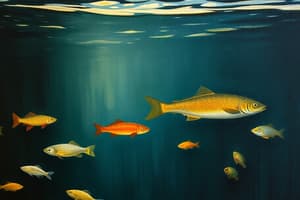Podcast
Questions and Answers
An ecosystem includes only the living organisms present in a specific area.
An ecosystem includes only the living organisms present in a specific area.
False (B)
Decomposers are responsible for breaking down dead matter and recycling nutrients.
Decomposers are responsible for breaking down dead matter and recycling nutrients.
True (A)
Primary consumers are organisms that only consume other consumers.
Primary consumers are organisms that only consume other consumers.
False (B)
Abiotic factors can include elements like sunlight and air.
Abiotic factors can include elements like sunlight and air.
Ecological succession can occur in lifeless areas after events like volcanic eruptions.
Ecological succession can occur in lifeless areas after events like volcanic eruptions.
Energy in an ecosystem flows only from consumers to producers.
Energy in an ecosystem flows only from consumers to producers.
The water cycle includes stages like evaporation and precipitation.
The water cycle includes stages like evaporation and precipitation.
Biodiversity is not important for ecosystem stability.
Biodiversity is not important for ecosystem stability.
Habitat destruction is a significant threat to ecosystems.
Habitat destruction is a significant threat to ecosystems.
Cultural services provided by ecosystems include only food and water supply.
Cultural services provided by ecosystems include only food and water supply.
Flashcards are hidden until you start studying
Study Notes
Ecosystems
-
Definition: An ecosystem is a biological community of interacting organisms and their physical environment.
-
Components:
- Biotic Factors: Living elements (e.g., plants, animals, microbes).
- Abiotic Factors: Non-living elements (e.g., sunlight, water, soil, air).
-
Types of Ecosystems:
- Terrestrial: Forests, grasslands, deserts, and tundras.
- Aquatic: Freshwater (lakes, rivers) and marine (oceans, coral reefs).
-
Energy Flow:
- Producers: Organisms that produce energy through photosynthesis (e.g., plants).
- Consumers: Organisms that consume producers or other consumers (e.g., herbivores, carnivores).
- Decomposers: Organisms that break down dead matter and recycle nutrients (e.g., fungi, bacteria).
-
Trophic Levels:
- Primary Producers: First trophic level (plants, algae).
- Primary Consumers: Second trophic level (herbivores).
- Secondary Consumers: Third trophic level (small carnivores).
- Tertiary Consumers: Fourth trophic level (top predators).
-
Biogeochemical Cycles:
- Water Cycle: Involves evaporation, condensation, and precipitation.
- Carbon Cycle: Movement of carbon through the atmosphere, organisms, and soil.
- Nitrogen Cycle: Conversion of nitrogen between its various forms, essential for organic life.
-
Ecological Succession:
- Primary Succession: Establishment of an ecosystem in a lifeless area (e.g., after a volcanic eruption).
- Secondary Succession: Recovery in an area that has been disturbed but retains soil (e.g., after a forest fire).
-
Biodiversity:
- Importance of species diversity for ecosystem resilience and stability.
- Threats: Habitat destruction, pollution, climate change.
-
Ecosystem Services:
- Provisioning Services: Supply of food, water, and raw materials.
- Regulating Services: Climate regulation, flood control, disease regulation.
- Cultural Services: Recreational, spiritual, and educational benefits.
- Supporting Services: Nutrient cycling, soil formation.
-
Human Impact:
- Overexploitation of resources, pollution, and habitat destruction.
- Conservation efforts focused on protecting and restoring ecosystems.
### Ecosystems
- Definition: An ecosystem is a community of organisms and their physical environment, interacting as a whole.
- Components: Ecosystems consist of both living (biotic) and non-living (abiotic) elements.
- Biotic: These include plants, animals, and microorganisms.
- Abiotic: These encompass sunlight, water, soil, and air.
- Types: Ecosystems can be terrestrial or aquatic.
- Terrestrial: These include forests, grasslands, deserts, and tundras.
- Aquatic: These can be freshwater (lakes, rivers) or marine (oceans, coral reefs).
- Energy Flow: Ecosystems have a distinct flow of energy.
- Producers: Organisms like plants that produce energy through photosynthesis.
- Consumers: Organisms that rely on consuming other organisms, including herbivores, carnivores.
- Decomposers: Organisms like fungi and bacteria that break down dead organic matter and recycle nutrients.
- Trophic Levels: The feeding hierarchy in an ecosystem is organized into trophic levels.
- Primary Producers: The first level are plants and algae.
- Primary Consumers: The second level are herbivores.
- Secondary Consumers: The third level are smaller predators.
- Tertiary Consumers: The fourth level are top predators.
- Biogeochemical Cycles: These cycles are vital for the continuous flow of matter within the ecosystem:
- Water Cycle: Water evaporates, condenses, and precipitates, forming a continuous loop.
- Carbon Cycle: Carbon moves through the atmosphere, organisms, and soil.
- Nitrogen Cycle: Nitrogen is converted between various forms, crucial for sustaining life.
- Ecological Succession: The gradual change in an ecosystem's species composition over time.
- Primary Succession: The establishment of an ecosystem in a completely lifeless area, like after a volcanic eruption.
- Secondary Succession: The recovery of an ecosystem after disturbance, but retaining soil, like after a forest fire.
- Biodiversity: The diverse array of life within an ecosystem.
- Importance: Biodiversity is crucial for an ecosystem's resilience and stability.
- Threats: Habitat destruction, pollution, and climate change pose significant threats to biodiversity.
- Ecosystem Services: The multitude of benefits ecosystems provide to humans.
- Provisioning Services: These include the supply of food, water, and raw materials.
- Regulating Services: These encompass climate regulation, flood control, and disease regulation.
- Cultural Services: These provide recreational, spiritual, and educational benefits.
- Supporting Services: These include nutrient cycling and soil formation.
- Human Impact: Human activities have significant consequences for ecosystems.
- Overexploitation of resources, pollution, and habitat destruction can lead to ecological imbalance.
- Conservation efforts focus on protecting and restoring ecosystems to maintain their vital services.
Studying That Suits You
Use AI to generate personalized quizzes and flashcards to suit your learning preferences.




